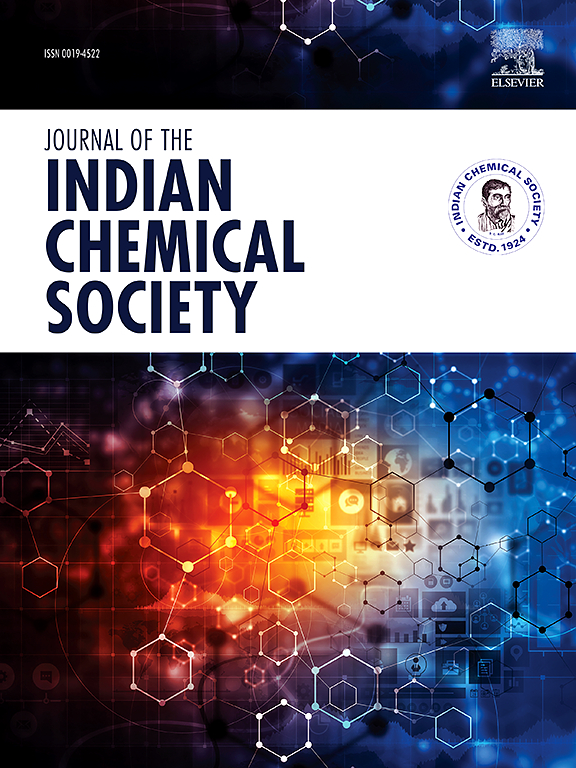释放双功能电催化剂的潜力:设计高效的Ni@MnS/SGCN纳米复合材料用于清洁能源转换
IF 3.2
4区 化学
Q2 CHEMISTRY, MULTIDISCIPLINARY
引用次数: 0
摘要
当今世界面临的两个主要问题是全球变暖和化石燃料枯竭。使用氢作为替代能源可能是解决这些问题的一种方法。电化学水分解是一种可持续的、可再生的、对环境有益的能源。困难的问题是创造一种强大的、负担得起的、有效的双重用途电催化剂,以增加电化学水分解。过渡金属硫化物由于其优异的导电性,被广泛应用于电化学储能系统中。本研究首先采用MnS作为电催化剂,然后通过掺杂和合成复合材料两种方法来提高其电催化性能。采用简便的共沉淀法制备了一系列镍掺杂MnS和6% Ni@MnS复合材料,分别具有不同重量百分比的镍(10%、8%、6%、4%和2wt %)和不同重量百分比的SGCN(10、30、50、70和90% wt. %)。采用XRD、SEM和EDX对电催化剂的组成、尺寸和结构进行了表征。电催化剂作为工作电极,采用滴铸法放置在FTO玻璃上。通过EIS、CV、LSV和时间电位分析表明,掺杂和复合材料的生产增加了电化学水分解的活性。70% Ni@MnS/SGCN在过电位380 mV和650 mV的低过电位条件下,析氧反应(OER)和析氢反应(HER)的电流密度达到10 mA/cm2时,产生最佳的电化学水分解活性。结果表明,70%的复合材料有可能在水裂解过程中用作电催化剂。本文章由计算机程序翻译,如有差异,请以英文原文为准。
Unleashing the potential of bifunctional electrocatalyst: Designing efficient Ni@MnS/SGCN nanocomposite for clean energy conversion
The two main problems facing the world now are global warming and fossil fuel depletion. Using hydrogen as a substitute energy source is one way to potentially solve these issues. A sustainable, renewable, and environmentally beneficial energy source is electrochemical water splitting among the various energy routes available. The difficult problem is to create a strong, affordable, and effective dual-purpose electrocatalyst that increases electrochemical water splitting. Because of their strong and excellent electrical conductivity, transition metal sulfides are utilized in electrochemical energy storage systems. MnS is employed as the electrocatalyst in this work initially, and its electrocatalytic properties are then increased by two methods: doping and synthesis of composite material. The facile and simple co-precipitation method is employed to create a series of Ni-doped MnS with different percentages of the weight of Nickel (10 %, 8 %, 6 %, 4 %, and 2 wt %) and 6 % Ni@MnS composite material with varied weight percentages of SGCN (10, 30, 50, 70, and 90 % wt. %). The electrocatalyst is characterized using XRD, SEM and EDX to examine its composition, size, and structure. Electro-catalysts are employed as working electrodes and are placed using the drop-casting method on the FTO glass. Doping and the production of composite materials increase the activity of electrochemical water splitting, as demonstrated by EIS, CV, LSV, and chronopotentiometry. 70 % Ni@MnS/SGCN produces the optimum electrochemical water splitting activity when used with a lower overpotential of 380 mV for oxygen evolution reaction (OER) and 650 mV for hydrogen evolution reaction (HER) to attain 10 mA/cm2 current density. The results thus indicate that 70 % composite material could potentially have been employed as an electrocatalyst in the process of water splitting.
求助全文
通过发布文献求助,成功后即可免费获取论文全文。
去求助
来源期刊
CiteScore
3.50
自引率
7.70%
发文量
492
审稿时长
3-8 weeks
期刊介绍:
The Journal of the Indian Chemical Society publishes original, fundamental, theorical, experimental research work of highest quality in all areas of chemistry, biochemistry, medicinal chemistry, electrochemistry, agrochemistry, chemical engineering and technology, food chemistry, environmental chemistry, etc.

 求助内容:
求助内容: 应助结果提醒方式:
应助结果提醒方式:


